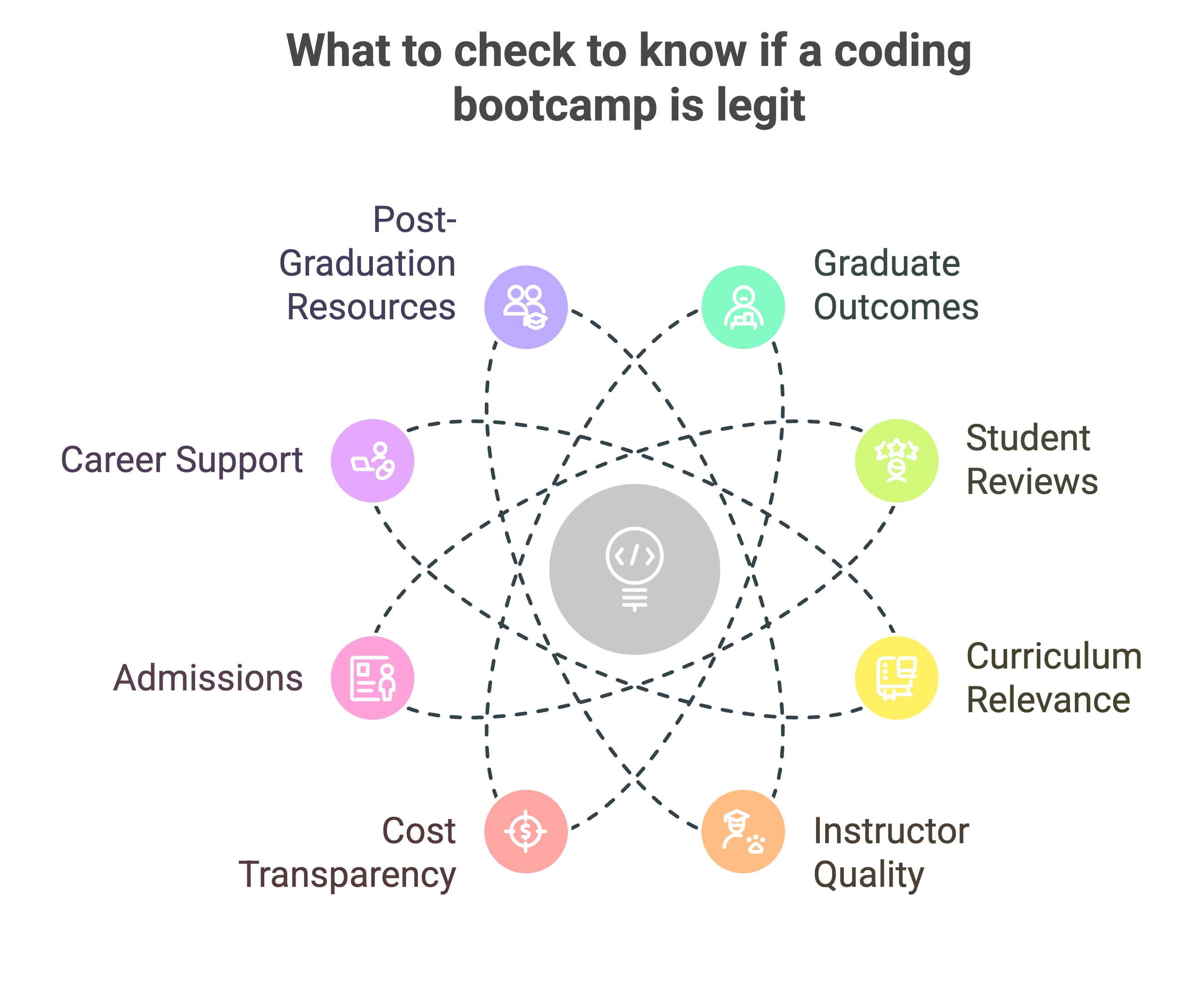Coding bootcamps have exploded in popularity as a fast-track way to break into the tech industry. With the promise of high salaries and job-ready skills in just a few months, it's no wonder so many people are considering them. But not all coding bootcamps are created equal—some are excellent, while others make big promises without delivering results.
So, how do you separate the good from the bad? Here’s how to spot a legit coding bootcamp—and avoid the scams.

1. Check Graduate Outcomes & Job Placement Rates
One of the best ways to evaluate a coding bootcamp is by looking at graduate outcomes. A reputable program will provide clear data on job placement rates, salaries, and the types of companies hiring their alumni.
✅ Signs of a Good Bootcamp:
- Transparent job placement rates with detailed reports (e.g., "85% of graduates found tech jobs within 6 months").
- Partnerships with reputable tech companies for hiring.
- Alumni success stories that you can verify on LinkedIn.
🚩 Red Flags:
- Vague or misleading claims like “90% of graduates find jobs” without specifying job types.
- No publicly available data or difficulty finding alumni success stories.
- Claims that guarantee a job—no program can truly promise employment.
2. Read Student & Alumni Reviews
Before committing, check what past students have to say. Independent review sites like Course Report, SwitchUp, and even Reddit can give you unfiltered insights into a bootcamp’s quality.
✅ Signs of a Good Bootcamp:
- Consistently positive reviews highlighting strong instruction, support, and career services.
- Alumni openly share their experiences and recommend the program.
- Balanced feedback—no bootcamp is perfect, but constructive criticism is normal.
🚩 Red Flags:
- Many complaints about misleading job placement stats or lack of support.
- Overwhelmingly negative reviews about instructors, outdated curriculum, or unresponsive career services.
- Suspiciously few or overly generic positive reviews that sound scripted.
3. Evaluate the Curriculum & Industry Relevance
A good bootcamp should teach modern, in-demand technologies that align with employer needs. Beware of programs that focus on outdated languages or lack depth in their curriculum.
✅ Signs of a Good Bootcamp:
- Covers essential programming languages (e.g., JavaScript, Python, React, databases).
- Includes hands-on projects and real-world applications.
- Teaches problem-solving, algorithms, and best coding practices.
🚩 Red Flags:
- Outdated tech stack or missing key industry-relevant skills.
- Too much emphasis on theory without real coding exercises.
- No capstone projects or portfolio-building opportunities.
4. Look at Instructor Quality & Support
The quality of instruction makes a huge difference in your learning experience. Strong bootcamps hire experienced industry professionals who know how to teach.
✅ Signs of a Good Bootcamp:
- Instructors have real-world experience in software development.
- Provides 1:1 mentorship, office hours, or teaching assistants.
- Support systems for students who need extra help.
🚩 Red Flags:
- Instructors with little to no industry experience.
- Poor student-instructor ratio, making it difficult to get help.
- Minimal feedback or mentorship throughout the course.
5. Assess Transparency in Cost & Financing
A legit bootcamp is upfront about costs and offers flexible payment options. Be wary of programs that hide fees or pressure you into enrolling.
✅ Signs of a Good Bootcamp:
- Clearly lists tuition costs and financing options (scholarships, ISAs, payment plans).
- No hidden fees or surprise costs.
- Offers refunds or trial periods to ensure it’s a good fit.
🚩 Red Flags:
- Hard-to-find pricing information or unclear financing terms.
- Pressure tactics like “limited-time discounts” to rush enrollment.
- Income Share Agreements (ISAs) with predatory terms.
6. Consider Admissions & Prerequisites
A selective admissions process usually means the bootcamp is serious about student success. If anyone can enroll without assessment, that’s a red flag.
✅ Signs of a Good Bootcamp:
- Has a screening process (coding challenge, interview, or prerequisite coursework).
- Provides prep courses or resources for beginners.
- Ensures students are ready for the intensity of the program.
🚩 Red Flags:
- No admissions requirements—accepts anyone who can pay.
- No preparation resources for those with little to no coding experience.
7. Investigate Career Support & Networking Opportunities
A strong coding bootcamp doesn’t just teach you to code—it helps you land a job. Look for career coaching, resume support, and employer partnerships.
✅ Signs of a Good Bootcamp:
- Offers resume reviews, mock interviews, and networking events.
- Has career coaches or job placement assistance.
- Connects students with employers through hiring fairs or alumni networks.
🚩 Red Flags:
- No structured career support beyond coursework.
- Lack of employer connections or alumni hiring network.
8. Look for Post-Graduation Community & Resources
The best bootcamps continue to support their graduates through alumni networks, job resources, and continued learning opportunities.
✅ Signs of a Good Bootcamp:
- Lifetime access to learning materials.
- Active alumni community for networking and referrals.
- Ongoing career support and events.
🚩 Red Flags:
- No community or support after graduation.
- Alumni have difficulty staying in touch or getting help post-bootcamp.
Why Sigma School is a Legit Coding Bootcamp
If you're looking for a coding bootcamp that checks all these boxes, Sigma School is a top choice.
Sigma School has helped countless students break into tech, and their strong hiring network ensures graduates have real job opportunities. Check them out today and start your coding journey with confidence!
Conclusion
Not all coding bootcamps are worth your time and money. By checking graduate outcomes, reviews, curriculum, instructor quality, cost transparency, career support, and alumni networks, you can spot a legit program and avoid scams.


